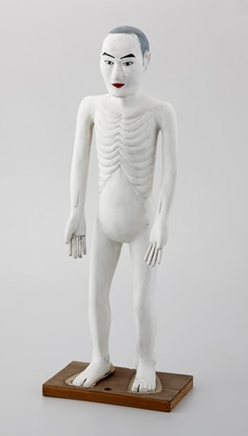 |
The Medical Museum of Nagoya University is located on the fourth floor of the Medical Library. It collects, preserves, and exhibits antique medical books, historical medical instruments, photographs and other items to promote understanding of the history of the Nagoya University School of Medicine in the context of the Tokai district and to look forward to the future of medical science. Parts of the collections can be accessed through the Digital Archive. Registration at the Medical Library counter is required for the actual use of these materials. |
|
1. The medical world in Owari at the end of the Edo Period |
|
|
 |
The Meridian Doll
When "Anatomische Tabellen1" was translated into Japanese and published as "Kaitai Shinsho (New Book of Anatomy)" by SUGITA Genpaku (1733-1817) et al. in the Edo period, it was proved that Japan had reached the necessary level to assimilate Western science and technology. This new book was a monumental translation which introduced the concept of "anatomy" to Japan, and in this sense is regarded as the beginning of modern medical science in Japan. The first dissection of a human body in Nagoya was carried out at "Otameshi-ba" in Bunsei year 4 (1821), half a century after the publication of "Kaitai Shinsho".
1. Written in 1731 by German anatomist Johann Adam KULMUS
After this, a number of medical texts were translated from Dutch into Japanese, but it was not until Philipp Franz von SIEBOLD (1796-1866) visited Japan that learning Western medicine directly from Western doctors began. SIEBOLD, who arrived in Japan as a medical officer for the Dutch commercial attaché in Bunsei year 6 (1823), treated Japanese patients and lectured on medicine to many Japanese scholars who wished to study under him, educating them by having them write reports at his private school, "Narutaki-juku", a window on the West established for the purpose of market research.
Although his education was not systematic, SIEBOLD may be said to be a pioneer among foreign teachers employed by the government in the early years of the Meiji period, in the sense that he lectured on Western medicine and science to the Japanese directly in Dutch. Most of his students - around 60 people, including ITO Genboku (1800-1871), TOTSUKA Seikai (1799-1876), TAKENOUCHI Gendo (1805-1880), ITO Keisuke (1803-1901) and others - became leaders in "Rangaku" (Dutch studies) before and after the Meiji Restoration.
The first systematic program of Western medical education was offered by POMPE VAN MEERDERVOORT (1829-1908), a naval surgeon from the Netherlands, who arrived in Nagasaki to serve as a director of the Medical Training Institute in Ansei year 4 (1857). Based on the medical curriculum of the military school of medicine in Utrecht, POMPE fostered professionals who would become leaders of the Meiji-period medical community, such as MATSUMOTO Ryojun (1832-1907), NAGAYO Sensai (1838-1902) and SATO Takanaka (1827-1882). Also studying under POMPE were SHIBA Ryokai (1839-1879), a brilliant linguist who served as an official interpreter at the Public Medical Training School, the predecessor of the Nagoya University School of Medicine; YOKOI Nobuyuki (1846-1891), who started a private school named "Kosei-gakusha" near the Nagoya castle moat and served as president of the Public Medical School; and KONDO Tanpei (1844-1929), the founder of "Mippo-gijuku", a private medical school in Mikawa. |
The immediate pupils of SIEBOLD and POMPE thus started Western-style hospitals or private medical schools in their hometowns, educating many second-generation disciples, who trained the next generation; Dutch medicine thus gradually spread throughout Japan. Finally, specialists in Dutch medicine were produced from among general practitioners and village doctors, and many doctors of Chinese medicine incorporated elements of Dutch medicine, becoming "eclectic doctors". One of the reasons smallpox vaccination spread in such a short time in Japan and modern schools of medicine were established one after another was that these specialists in Dutch medicine and eclectic doctors existed throughout the country. In Owari, the first "Shutosho", or smallpox vaccination clinic, was established in Kaei year 5 (1852) at Hirokojiotsu-machi by ITO Keisuke (1803-1901), who wrote a book entitled "Igirisukoku Shuto Kisho (A Book on Smallpox Vaccination in Britain" and introduced the bovine smallpox vaccination method. However, there was strong opposition to this from doctors of traditional Chinese medicine. ASAI Saizan, Director of the Owari domain's medical school, "Igakkan", heavily criticized ISHII Ryuan, one of the directors of the vaccination clinic, and even beat him, shouting as follows: "Taking a diseased spot from a cow and putting it into a human body of our divine nation… you are a traitor to the nation, a dog, a pig." |
|
|
|
|